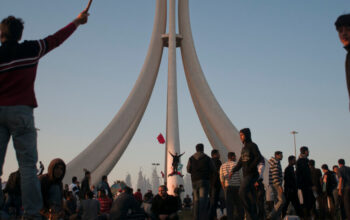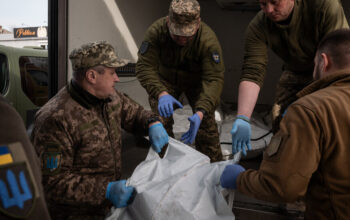
SEOUL — North Korea has test-fired a flurry of missiles in recent weeks, culminating Friday with its second intercontinental ballistic missile this month and one of its most powerful yet, landing in waters west of Hokkaido, Japan’s northernmost island. The test missile, which missile experts said could reach anywhere in the United States, was the latest demonstration of the North’s increasingly sophisticated military arsenal.
Its leader, Kim Jong-un, watched the most recent launch with his daughter and wife, according to a statement published by KCNA, the North Korean state news agency, on Saturday. It called the test a milestone in the strengthening of the country’s nuclear force.
Mr. Kim has been seeking to solidify the country’s stance as a nuclear-armed power and his position at its helm. With Washington occupied with Russia’s war in Ukraine and diplomacy with China, he probably senses an opportunity to show off his advancing weapons and provoke his enemies.
Mr. Kim earlier this year pledged to expand the North’s nuclear arsenal “at the fastest possible speed.” He recently reaffirmed that pledge, saying that he would “react to nukes with nukes” and engage in “total confrontation” if threats from his enemies continued, North Korean state media said on Saturday.
North Korea has carried out 34 weapons tests this year, involving about 88 ballistic and cruise missiles. In a single day this month, North Korea fired at least 23 missiles, one of which fell into waters 35 miles off South Korea’s east coast, prompting islanders to seek shelter underground. It has also flown an intermediate-range ballistic missile over Japan.
President Biden has warned of “responses” if North Korea continues to escalate tensions on the Korean Peninsula. At his recent meeting with China’s leader, Xi Jinping, Mr. Biden reaffirmed that the United States would defend itself and its allies from the North’s threats.
While it is hard to get a clear, up-to-date picture of North Korea’s military capabilities, analysts and observers agree that in the decade under Mr. Kim’s rule, North Korea has rapidly expanded its nuclear program and modernized its missile fleet. The expansion of the arsenal is a growing threat to the United States and its allies in the region. Here’s what’s in it.
There are an increasing number of nuclear warheads.
North Korea’s ballistic missiles can carry nuclear warheads, and the country conducted six increasingly sophisticated underground nuclear tests between 2006 and 2017. The last four of them happened under Mr. Kim.
This year, Washington and Seoul have repeatedly warned that North Korea is gearing up for another nuclear test at Punggye-ri, where the North conducted all of its previous underground nuclear tests.
North Korea’s Missile Tests
Its last and most powerful nuclear test was conducted in September 2017, when North Korea claimed to have detonated a thermonuclear, or hydrogen, bomb. Estimates of the device’s explosive power ranged from 50 to 300 kilotons.
A mere 100 kilotons would make the test six times as powerful as the bomb dropped on Hiroshima in 1945.
North Korea has extracted plutonium, an atomic bomb fuel, from its Soviet-designed nuclear reactor in Yongbyon, north of Pyongyang. It also runs centrifuges to produce weapons-grade enriched uranium, another bomb fuel.
As of 2021, North Korea had enough fissile material for 40 to 50 nuclear warheads and could produce enough for six or seven bombs a year, according to an estimate by the Arms Control Association. The United Nations’ nuclear watchdog last year said that North Korea may be preparing to ramp up its production of plutonium and highly enriched uranium in Yongbyon.
Its missiles can fly longer ranges.
North Korea demonstrated the biggest strides in its weapons capabilities in 2017.
That year, the country fired its intermediate-range ballistic missile, Hwasong-12, over Japan and threatened an “enveloping” strike around the American territory of Guam. It also test-fired Hwasong-14 and Hwasong-15, the country’s first intercontinental ballistic missiles.
By the end of the year, Mr. Kim claimed that his country had the ability to launch a nuclear strike against the continental United States.
After 2017, Mr. Kim stopped testing nuclear weapons and long-range missiles but threatened to end his moratorium when talks with President Trump collapsed in 2019.
During a nighttime military parade in the fall of 2020, North Korea displayed a new, untested ICBM that looked bigger than any of the previous ones.
In March, North Korea appeared to conduct its most powerful ICBM test to date. While state media called it the larger Hwasong-17, showcasing the missile in a Hollywood-style propaganda video, South Korea later said it appeared to be the older Hwasong-15. The South said that clips and photos of the launch were faked to exaggerate Mr. Kim’s weapons achievements for a domestic audience.
The missile launched on Friday appeared to be a Hwasong-17, South Korean defense officials said.
The biggest unanswered question is whether North Korea has mastered the technology needed to send an intercontinental nuclear warhead into space and then guide it back through the earth’s atmosphere to its target. North Korea has yet to demonstrate that its warhead can survive the intense heat and friction created by re-entry.
Its weapons are getting more sophisticated.
When North Korea resumed missile tests in 2019 after the collapse of the Kim-Trump talks, the tests featured three new weapons, code-named KN-23, KN-24 and KN-25 by outside experts.
Each marked big advances in North Korea’s short-range ballistic missile program.
Unlike its older missiles that used liquid fuel, all three of the new missiles used solid fuel. The new solid-fuel weapons, mounted on mobile launchers, are easier to transport and hide and take less time to prepare. And at least two of them, KN-23 and KN-24, could perform low-altitude maneuvers, making them harder to intercept.
At a military parade in 2021, North Korea displayed what looked like a bigger, upgraded version of KN-23. Photos released by the North Korean media indicate that it was the newly developed tactical guided missile North Korea launched in March of that year.
The new missile was developed to be larger than KN-23 in order to carry a bigger warhead and more fuel. North Korea claimed that the missile could carry a 2.5-ton warhead. South Korea’s defense minister later admitted that his military missed part of the North Korean missile’s trajectory because of its midair maneuvering.
North Korea also test-launched “long-range cruise missiles” in September 2021. It called them a “strategic weapon,” indicating that it would arm the new missile with nuclear warheads. Also in 2021, North Korea began testing what it called a ballistic missile with a detachable “hypersonic” gliding warhead.
The country’s missile tests have demonstrated that they were becoming harder to intercept.
It has also been testing submarine-launched ballistic missiles since 2015.
During military parades in 2020 and 2021, North Korea displayed what looked like two upgraded versions of its Pukguksong submarine-launched ballistic missiles. It currently has only one submarine that can launch a ballistic missile but says it is building a new one with greater capabilities.
The arsenal is no bargaining chip, Kim Jong-un says.
North Korea has one of the largest standing armies in the world, with more than one million soldiers. But much of its equipment is old and obsolete, and the military lacks fuel and spare parts.
It has sought to make up for its shortcomings by building nuclear weapons, which it says are primarily a deterrent.
In a speech before the Supreme People’s Assembly in September, Mr. Kim said the North would not give up its nuclear weapons as long as nuclear weapons and “imperialism” exist. He said: “We have drawn the line of no retreat regarding our nuclear weapons, so that there will be no longer any bargaining over them.”
“Pyongyang has been in a dizzying sprint to build an arsenal that contains the kinds of advanced capabilities you would find in the United States or Russia,” said Adam Mount, senior fellow at the Federation of American Scientists. “But for the most part, these have been single-serving demonstrations: Pyongyang tests the system once, then moves onto the next one. It’s less clear whether they will complete testing or deployment of any or all of these systems.”



